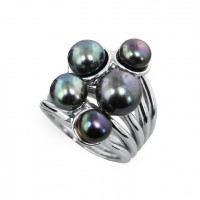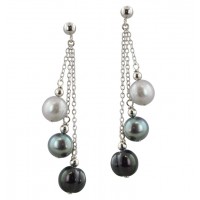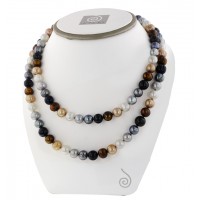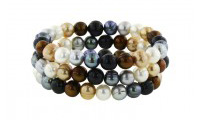Our Selection of Fine Pearl Jewelry is Stunning
Pearls have been valued as precious stones for more than 4000 years. Two types of pearls popular in jewelry making today are Akoya Cultured Pearls and Freshwater Pearls. The pinkish-white round pearls that people think of as the classic strand of pearls are most likely Akoya cultured pearls (named for the type of oyster used to produce them). Freshwater pearls are known for their gorgeous colors, variety and affordable prices. These organic beauties are popular in jewelry designs because of their warm, feminine and unique shapes and colors.
The term Cultured Pearls is often misunderstood or misused, but the meaning is actually rather simple, a Cultured Pearl is any pearl product where man starts the pearl growth process. Virtually all of the pearls you find in jewelry stores are considered cultured pearls.
How are Cultured Pearls formed?
Most pearls are produced in either Japan or China, but they are also farmed in other parts of the Asia-Pacific area. It’s a painstaking process requiring just the right temperature and pH balance in the water used to cultivate these beautiful pearls. That’s why they can only be produced in certain parts of the world.
Learn more...
To culture Akoya pearls, one to two round shell beads are implanted into the tissue of a pearl oyster. In reaction to this irritant, the oyster begins to produce nacre, the lustrous white coating that creates the pearl. The longer the pearls are left in the water, the more coats of nacre they will have, which makes them larger and more beautiful. The bead remains forever within the pearl as its nucleus.
The process for Freshwater pearls is similar. Over many decades, freshwater cultured pearls came largely from Japan, but due to pollution the Japanese freshwater pearl culturing industry died out. China produces most freshwater pearls today. More than 99% of the freshwater pearls in the world come from lakes and rivers west of Shanghai.
To culture freshwater pearls, producers insert small pieces of “mantle tissue,” or reused pieces of shell, into the tissue of a large triangular mussel. In reaction to this irritant, the mussel begins to produce nacre, the lustrous coating that creates the pearl. As many as 20-30 pearls may be produced from one mussel in a harvest. This quantity allows China to produce some 1,500 tons of freshwater pearls a year.
The Chinese pearl industry has become so sophisticated that the size, shape and quality of freshwater pearls now can rival those of the Japanese Akoya cultured pearl.
Akoya Pearls
Higher-quality Akoya pearls are almost reflective in nature and appear to have several layers to them: this phenomenon is called luster. They occur naturally in colors such as pink, silver, cream, white, gold, gray and blue. They rarely occur in black, green or other exotic colors — if you see Akoya pearls in these colors, be sure to ask the seller if the color is enhanced.
Smoothness is a quality factor that affects the grade and price of Akoya pearls. Akoya pearls often come with at least a certain number of blemishes from the months of exposure to saltwater, sand and other natural elements. The blemishes are actually a good thing — they’re one way you know the pearl is real and not artificial. But the fewer blemishes there are, the more the pearl is worth.
Akoya pearls tend to be cultured for roundness — which is one of the reasons their nuclei are round shell beads. Akoya pearls are often valued for their roundness and the symmetry of their shape and size when used in pearl strands. The pearls range from 2mm to 10mm in circumference, the average size is 6mm to 7mm.
Akoya pearls are best known for their use in beautiful, well-matched pearl strands, which feature pearls that are nearly identical in size, shape, color and quality (luster and surface flaws). Akoya pearls are also popular in pendants, stud or drop earrings, and rings.
Freshwater Pearls
Freshwater cultured pearls come in a remarkable variety of colors: pink, gold, blue, green, peach, lavender, gray, white and cream. Because they are so abundant (and often inexpensive), freshwater pearls are also often dyed bolder, fashionable colors such as black, copper, red or other bright colors. This is an acceptable enhancement for freshwater pearls, but the jeweler who sells them to you should disclose it.
Freshwater pearls can be quite lustrous, but because they’re cultivated in a different kind of water, they don’t have quite the same sheen as Akoya cultured pearls. However they have more nacre (and are therefore less fragile) than their Japanese cousins, which have shell-bead nuclei and a layer of nacre on top. Some blemishes in the pearls are natural and even desirable — they prove that the pearl is real and not artificial — but smoothness and cleanliness of the pearl are factors in its price.
Freshwater pearls come in many different shapes. Producers have become quite skilled at creating almost perfectly round pearls, which are ideal for matched pearl strands. Freshwater pearls also commonly come in oblong or oval (potato) shapes or irregular “baroque” shapes. You’ll also see Keshi pearls, which are “free-form” shapes that often occur as accidents in the culturing process. Designers may prize these pearls for their uniqueness and beauty. Freshwater pearls typically appear in sizes from 2mm to 8mm; average sizes are 6mm to 7mm.
Freshwater pearls are less expensive than other pearls, and are very versatile because of their variety of colors and shapes, making them popular choices for jewelry designers. It’s common to see strands of freshwater pearls, but also to see freshwaters in fashion jewelry pieces such as pendants, earrings, bracelets and brooches.
Pearl Care
Pearls are delicate. The nacre on the outside of pearls is soft, it can wear or chip away over time if you don’t treat the pearls with extreme care.
Learn more...
1) Avoid keeping pearls together with hard gems and precious metals. The surface of a pearl is not as hard as those of other types of jewelry. If pearls come into contact with these objects, they can scratch very easily.
2) Remove pearl accessories before working around water. Water, surprisingly, is not good for pearls, to say nothing of soaps, bleach, and other substances that may happen to be present. Carefully wipe your pearls with a soft, dry cloth after each wearing.
3) Be especially careful around vinegar and fruit juices. It would not be an exaggeration to say that vinegar and acidic fruit juices are the natural enemies of pearls. If these liquids should come into contact with the pearls, clean the pearls immediately with a soft, dry cloth to avoid discoloration.
4) Also be careful not to get makeup, hairspray or harsh soaps or chemicals on your pearl jewelry. As with vinegar and fruit juice, pearls are very weak against cosmetics. In case of direct contact, clean the pearls at once–in this case with a moist cloth–and wipe dry as usual.
5) Store pearls in a dark place. Pearls do not do well under bright light, be it direct sunlight or fluorescent light. Take care to keep them in a case or drawer, safely out of the light.
One last thing to remember: it’s a good idea to restring pearls once every three years. The strings weaken over time regardless of wear; this simple preventative measure can save a lot of heartache. New England Jewelry is pleased to perform this service. Simply bring your pearl accessories to our store for a consultation.
Looking for something truly unique?
You’ve Come to the Right Place.
Our custom jewelry craftsmen are skilled in creating one-of-a-kind pieces. We are passionate about the quality of our jewelry. Our in-house graduate gemologist, designers, and expert jewelers are masters of both old-world and innovative, contemporary techniques. Whether you have a design in mind, or if you’re still gathering inspiration and need help exploring, our team will be able to provide the guidance you need, without a high-pressure sales pitch. Whatever your budget, we’ll work with you to create the perfect piece.






